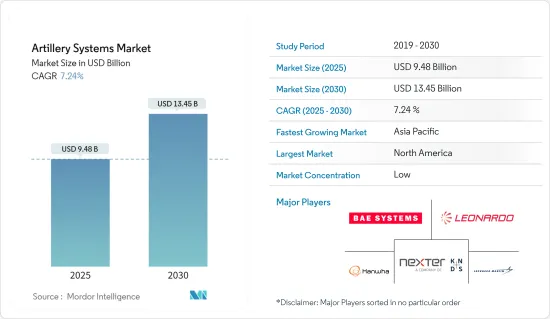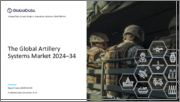
|
시장보고서
상품코드
1687384
세계의 포병 시스템 시장 : 점유율 분석, 산업 동향 및 통계, 성장 예측(2025-2030년)Artillery Systems - Market Share Analysis, Industry Trends & Statistics, Growth Forecasts (2025 - 2030) |
||||||
세계의 포병 시스템 시장 규모는 2025년 94억 8,000만 달러로 추정되며, 예측 기간 중(2025-2030년) CAGR 7.24%로 확대되어, 2030년에는 134억 5,000만 달러에 달할 것으로 예측됩니다.

주요 하이라이트
- COVID-19 팬데믹은 두 가지 중요한 점에서 시장에 영향을 미쳤습니다. 첫째, 세계 공급망과 제조 시설의 혼란으로 인해 포병 시스템의 생산과 납품이 지연되어 각국의 조달 일정에 영향을 미칠 수 있습니다. 둘째, 정부는 팬데믹 당면 과제를 해결하기 위해 많은 자원을 할당하고 있기 때문에 국방 예산이 재분배되거나 제약을 받았을 수 있으며 새로운 포병 시스템에 대한 투자에 영향을 미칠 수 있습니다.
- 신흥 국가의 군사비 증가는 신형 및 선진 포병 시스템의 개발 투자를 뒷받침하고 있습니다. 정교한 대포를 개발하기 위한 무기 근대화 프로그램의 개시는 보다 새로운 세대의 대포의 채용을 강화하고, 향후 수년간 시장 전망을 강화할 것으로 예상됩니다. 지역분쟁과 지정학적 긴장의 격화로 정밀한 공격과 신속한 대응이 가능한 고성능 포병 시스템에 대한 수요가 높아지고 있습니다. 또한 전쟁의 성질이 변화하고 감아 피해를 최소화하면서 우군을 지원하기 위한 고정밀 무기 및 탄약에 대한 수요가 높아지고 있는 것도 포병 시스템 시장 수요를 높이고 있습니다.
포병 시스템 시장 동향
포병 시스템 시장 성장을 지원하는 국방비 증가
- 국제전략정세의 큰 변화로 인해 국제안보시스템의 구성은 패권주의, 일국주의, 파워폴리틱스 증가에 의해 손상되어 현재 진행 중인 여러 세계 분쟁에 박차를 가하고 있습니다. 중동의 사우디아라비아와 이란의 냉전처럼 많은 나라들 사이에 존재하는 영토권의 불확실성은 지정 학적 상황을 방해하는 주요 원인 중 하나입니다.
- 이 점에서 각국 정부의 가장 흔한 반응은 자국의 안보를 향상시키기 위해 군사비를 늘리는 것입니다. 미국, 영국, 중국, 인도 등 군사대국은 군사화력과 전쟁능력 증강에 주력해 왔습니다. 기존의 방어 시스템의 전투 즉응성을 확보하기 위해, 군가 사용하는 무기 시스템을 근대화하기 위한 개발 및 조달 계획이 현재 진행중입니다. 또한 국산화를 동시에 추진함으로써 이러한 시스템의 현지 개발을 진행하고 있는 국가도 있습니다. 현재 국방예산 증가가 이러한 프로그램을 지원하고 있습니다.
- 우크라이나 침공은 중유럽과 서유럽의 군사비 결정에 즉시 영향을 미쳤습니다. 여기에는 여러 정부의 여러 해에 걸친 지출 증가 계획이 포함되었습니다. 세계 군사비는 2022년 8년 연속 증가하여 사상 최고의 2조 2,400억 달러에 달했습니다. 지출이 가장 급증한 것은 유럽에서(13% 증가) 러시아와 우크라이나의 지출이 대부분을 차지했습니다. 그러나 우크라이나에 대한 군사 원조와 러시아 위협 증가에 대한 우려는 동아시아 긴장과 마찬가지로 많은 다른 국가의 지출 결정에 강한 영향을 미쳤습니다.
- 미국은 여전히 세계 최대의 군사 지출국입니다. 미국의 군사비는 2022년에 8,770억 달러에 이르고, 이는 세계 군사비 전체의 39%를 차지하며 세계 2위 중국 군사비의 3배에 해당합니다.
- 각국이 군사 근대화를 위해 다액의 투자를 실시하고 있는 것이, 예측 기간중의 포병 시스템 시장의 성장을 지지할 가능성이 있습니다.
- 예를 들어, 2022년 12월, 리투아니아 국방성은 프랑스의 Nexter와 Caesar 18문의 구입 계약을 체결했습니다.
예측기간 동안 아시아태평양이 가장 높은 CAGR로 추이할 전망
- 아시아태평양은 예측기간 중에 높은 CAGR을 나타낼 것으로 예상됩니다.
- 예를 들어, 2022년 11월, Kalyani Strategic Systems Limited(인도)는 비분쟁 지역의 우호국에 155mm포를 수출하는 계약을 체결했습니다. 인도에 세계 최대의 대포공장을 설립한다고도 전해지고 있습니다.
포병 시스템 산업 개요
포병 시스템 시장은 세분화되어 있으며, 많은 세계 기업과 현지 기업들이 가격 경쟁과 기술 혁신을 통해 시장 성장에 크게 기여하고 있습니다. 시장 내 주요 기업에는 BAE Systems plc, Lockheed Martin Corporation, Hanwha Group, Leonardo S.p.A, Elbit Systems Ltd., and Nexter Group 등이 있습니다. 각 회사는 시장 점유율을 확대하기 위해 주로 포병 시스템 포트폴리오의 기능 강화에 주력하고 있습니다.
해외 기업은 수십억 장기 계약을 획득하기 위해 현지 기업과 경쟁하고 있으며, 고객 기반을 확대하고 기술적 전문 지식을 공유하기 위해 현지 기업과 제휴하고 있는 기업도 있습니다. 노후화한 시스템으로 대체하는 것으로, 육상 전력 강화를 위한 공백을 메우려고 하고 있는 미국에서도 수요가 높아지고 있습니다. 또, 과거 10년간에 있어서의 해군력 강화에 대한 관심의 고조는 프리게이트, 코르벳, 항공 모함, 구축함, 해양 함정의 대폭적인 신규 발주를 가져오고, 그것에 의해 신형포의 필요성이 생겨나고 있습니다.
예를 들어, 2023년 5월, Elbit Systems는 이스라엘 국방부와 네덜란드 국방부 간의 합의의 일환으로 네덜란드 왕립 육군에 PULS(Precise & Universal Launching System) 포병 로켓 시스템을 공급하는 3억 500만 달러 상당의 계약을 획득했다고 발표했습니다.
마찬가지로 2022년 11월 JPEO A&A와 ACC-Rock Island는 텍사스 주에 155mm 포금속 부품 생산 라인을 신설하기 위해 General Dynamics Ordnance and Tactical Systems에 새로운 태스크 오더를 발주했습니다.
기타 혜택
- 엑셀 형식 시장 예측(ME) 시트
- 3개월간의 애널리스트 서포트
목차
제1장 서론
- 조사의 전제조건과 시장 정의
- 조사 범위
제2장 조사 방법
제3장 주요 요약
제4장 시장 역학
- 시장 개요
- 시장 성장 촉진요인
- 시장 성장 억제요인
- 업계의 매력도 - Porter's Five Forces 분석
- 신규 참가업체의 위협
- 구매자 및 소비자의 협상력
- 공급기업의 협상력
- 대체품의 위협
- 경쟁 기업간 경쟁 관계의 강도
제5장 시장 세분화
- 유형
- 유탄포
- 박격포
- 대공포
- 로켓포
- 기타 유형(해군 및 해안 포병)
- 사정거리
- 단거리(5-30킬로미터)
- 중거리(31-60킬로미터)
- 장거리(60킬로미터 이상)
- 지역
- 북미
- 미국
- 캐나다
- 유럽
- 영국
- 독일
- 프랑스
- 러시아
- 스페인
- 기타 유럽
- 아시아태평양
- 중국
- 인도
- 일본
- 한국
- 호주
- 기타 아시아태평양
- 라틴아메리카
- 브라질
- 멕시코
- 기타 라틴아메리카
- 중동 및 아프리카
- 아랍에미리트(UAE)
- 사우디아라비아
- 이스라엘
- 남아프리카
- 기타 중동 및 아프리카
- 북미
제6장 경쟁 구도
- 벤더의 시장 점유율
- 기업 프로파일
- BAE Systems plc
- Hanwha Group
- Elbit Systems Ltd.
- Rostec
- Lockheed Martin Corporation
- Avibras Industria Aeroespacial SA
- Nexter Group
- Denel SOC Ltd
- Leonardo SpA
- Singapore Technologies Engineering Ltd
- RUAG Group
- Norinco International Cooperation Ltd.
- THALES
- Rheinmetall AG
제7장 시장 기회와 앞으로의 동향
JHS 25.05.02The Artillery Systems Market size is estimated at USD 9.48 billion in 2025, and is expected to reach USD 13.45 billion by 2030, at a CAGR of 7.24% during the forecast period (2025-2030).

Key Highlights
- The COVID-19 pandemic affected the market in two key ways. Firstly, disruptions in global supply chains and manufacturing facilities may have caused delays in the production and delivery of artillery systems, impacting procurement timelines for various countries. Secondly, with governments allocating significant resources to address the pandemic's immediate challenges, defense budgets might have been reallocated or constrained, potentially affecting investments in new artillery systems.
- The increasing military spending of emerging countries is helping them to invest in the development of new and advanced artillery systems. The initiation of weapon modernization programs to develop sophisticated artillery is anticipated to bolster the adoption of newer generation artillery, thus bolstering the market prospects in the coming years. Escalating regional conflicts and geopolitical tensions have led to a growing demand for sophisticated artillery systems capable of precision strikes and quick response times. Also, the changing nature of warfare and the growing demand for high-precision arms and ammunition to support friendly troops while minimizing collateral damage has bolstered the demand for the artillery systems market.
Artillery Systems Market Trends
Increasing Defense Expenditure Supporting the Growth of the Artillery Systems Market
- On account of the profound changes in the international strategic landscape, the configuration of the international security system has been undermined by the growing hegemonism, unilateralism, and power politics that have fueled several ongoing global conflicts. Uncertainties in territorial rights between many countries, like the Saudi-Iran cold war in the Middle East, are among the major causes disturbing the geopolitical climate.
- The most common reaction of governments, in this regard, is to increase military spending to improve security in their respective countries. Military powerhouses, such as the United States, the United Kingdom, China, and India, have been focused on augmenting their military firepower and warfare capabilities. To ensure combat readiness of existing defense systems, development and procurement programs are currently underway to modernize the weapon systems used by the armed forces. A simultaneous push for indigenization is also driving several countries' local development of such systems. The increase in defense budgets currently supports these programs.
- The invasion of Ukraine had an immediate impact on military spending decisions in Central and Western Europe. This included multi-year plans to boost spending from several governments. World military spending grew for the eighth consecutive year in 2022 to an all-time high of USD 2240 billion. By far, the sharpest rise in spending (+13 percent) was seen in Europe and was largely accounted for by Russian and Ukrainian spending. However, military aid to Ukraine and concerns about a heightened threat from Russia strongly influenced many other states' spending decisions, as did tensions in East Asia.
- The United States remains by far the world's biggest military spender. US military spending reached USD 877 billion in 2022, which was 39 percent of total global military spending and three times more than the amount spent by China, the world's second-largest spender.
- Countries' significant investments to modernize their military may support the artillery systems market growth during the forecast period. Countries are focused on developing long-range fire capabilities to achieve a tactical advantage on the battlefield. To develop long-range precision fire capabilities, countries like the United States are initiating the procurement of artillery systems.
- For instance, in December 2022, Lithuania's Defense Ministry signed a contract with the French group Nexter for the purchase of 18 Caesar artillery guns.
Asia-Pacific is Expected to Witness the Highest CAGR During the forecast period
- Asia-Pacific is expected to register a high CAGR during the forecast period. The escalated tensions between the countries in this region have encouraged the rapid modernization of the armed forces. Countries like China, India, Australia, Japan, and South Korea are significantly investing in the development, building, and procurement of artillery systems.
- For instance, in November 2022, Kalyani Strategic Systems Limited (India) signed a deal to export 155mm artillery guns to a friendly nation in a non-conflict zone. The deal is worth USD 155 million, and the arms are to be exported by 2025. The Kalyani Group is also reported to establish the world's largest artillery factory in India. In May 2023, The People's Liberation Army-Strategic Support Force (PLA-SSF) of China gave a contract to PLA-SSF Northwest Institute of Nuclear Technology (NINT) to produce 203-millimeter artillery guns.
Artillery Systems Industry Overview
The artillery systems market is fragmented, with many global and local players contributing significantly to the growth of the market through competitive pricing and innovation. Some of the major companies in the artillery systems market include BAE Systems plc, Lockheed Martin Corporation, Hanwha Group, Leonardo S.p.A, Elbit Systems Ltd., and Nexter Group. The companies are mainly focusing on enhancing the capabilities of their artillery systems portfolio to increase their market share.
Foreign players are competing with local players to gain multi-billion long-term contracts. Some players have also partnered with local companies to expand their customer base and share technical expertise. Tensions across Eastern Europe, the Middle East, and Asia-Pacific are generating the demand for new artillery systems. The demand is also higher in the US, which is trying to fill in the gaps to strengthen its land forces by replacing the aging systems with new artillery systems. Also, a growing focus on strengthening naval capabilities over the past decade has resulted in significant new orders for frigates, corvettes, aircraft carriers, destroyers, and offshore vessels, thereby generating the need for new artillery guns.
For instance, in May 2023, Elbit Systems announced that as part of an agreement between the Israeli Ministry of Defense and the Netherlands Ministry of Defense, it was awarded a contract worth USD 305 million to supply Precise & Universal Launching System (PULS) artillery rocket systems to the Royal Netherlands Army.
Likewise, In November 2022, JPEO A&A and ACC-Rock Island awarded a new task order to General Dynamics Ordnance and Tactical Systems to build a new 155 mm artillery metal parts production line in Texas that will utilize free-flow forming technology, which delivers flexible, cost-effective, and precise metal forming with higher machine speeds and more accurate, uniform products.
Additional Benefits:
- The market estimate (ME) sheet in Excel format
- 3 months of analyst support
TABLE OF CONTENTS
1 Introduction
- 1.1 Study Assumptions and Market Definition
- 1.2 Scope of the Study
2 RESEARCH METHODOLOGY
3 EXECUTIVE SUMMARY
4 MARKET DYNAMICS
- 4.1 Market Overview
- 4.2 Market Drivers
- 4.3 Market Restraints
- 4.4 Industry Attractiveness - Porter's Five Forces Analysis
- 4.4.1 Threat of New Entrants
- 4.4.2 Bargaining Power of Buyers/Consumers
- 4.4.3 Bargaining Power of Suppliers
- 4.4.4 Threat of Substitute Products
- 4.4.5 Intensity of Competitive Rivalry
5 MARKET SEGMENTATION (Market Size and Forecast by Value - USD billion, 2018 - 2031)
- 5.1 Type
- 5.1.1 Howitzer
- 5.1.2 Mortar
- 5.1.3 Anti-air Artillery
- 5.1.4 Rocket Artillery
- 5.1.5 Other Types (Naval and Coastal Artillery)
- 5.2 Range
- 5.2.1 Short Range (5-30 kilometers)
- 5.2.2 Medium Range (31-60 kilometers)
- 5.2.3 Long Range (Above 60 kilometers)
- 5.3 Geography
- 5.3.1 North America
- 5.3.1.1 United States
- 5.3.1.2 Canada
- 5.3.2 Europe
- 5.3.2.1 United Kingdom
- 5.3.2.2 Germany
- 5.3.2.3 France
- 5.3.2.4 Russia
- 5.3.2.5 Spain
- 5.3.2.6 Rest of Europe
- 5.3.3 Asia-Pacific
- 5.3.3.1 China
- 5.3.3.2 India
- 5.3.3.3 Japan
- 5.3.3.4 South Korea
- 5.3.3.5 Australia
- 5.3.3.6 Rest of Asia-Pacific
- 5.3.4 Latin America
- 5.3.4.1 Brazil
- 5.3.4.2 Mexico
- 5.3.4.3 Rest of Latin America
- 5.3.5 Middle East and Africa
- 5.3.5.1 United Arab Emirates
- 5.3.5.2 Saudi Arabia
- 5.3.5.3 Israel
- 5.3.5.4 South Africa
- 5.3.5.5 Rest of Middle East and Africa
- 5.3.1 North America
6 COMPETITIVE LANDSCAPE
- 6.1 Vendor Market Share
- 6.2 Company Profiles
- 6.2.1 BAE Systems plc
- 6.2.2 Hanwha Group
- 6.2.3 Elbit Systems Ltd.
- 6.2.4 Rostec
- 6.2.5 Lockheed Martin Corporation
- 6.2.6 Avibras Industria Aeroespacial SA
- 6.2.7 Nexter Group
- 6.2.8 Denel SOC Ltd
- 6.2.9 Leonardo S.p.A
- 6.2.10 Singapore Technologies Engineering Ltd
- 6.2.11 RUAG Group
- 6.2.12 Norinco International Cooperation Ltd.
- 6.2.13 THALES
- 6.2.14 Rheinmetall AG

















